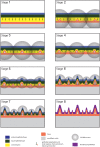Bony pseudoteeth of extinct pelagic birds (Aves, Odontopterygiformes) formed through a response of bone cells to tooth-specific epithelial signals under unique conditions
- PMID: 30154516
- PMCID: PMC6113277
- DOI: 10.1038/s41598-018-31022-3
Bony pseudoteeth of extinct pelagic birds (Aves, Odontopterygiformes) formed through a response of bone cells to tooth-specific epithelial signals under unique conditions
Abstract
Modern birds (crown group birds, called Neornithes) are toothless; however, the extinct neornithine Odontopterygiformes possessed bone excrescences (pseudoteeth) which resembled teeth, distributed sequentially by size along jaws. The origin of pseudoteeth is enigmatic, but based on recent evidence, including microanatomical and histological analyses, we propose that conserved odontogenetic pathways most probably regulated the development of pseudodentition. The delayed pseudoteeth growth and epithelium keratinization allowed for the existence of a temporal window during which competent osteoblasts could respond to oral epithelial signaling, in place of the no longer present odontoblasts; thus, bony pseudoteeth developed instead of true teeth. Dynamic morphogenetic fields can explain the particular, sequential size distribution of pseudoteeth along the jaws of these birds. Hence, this appears as a new kind of deep homology, by which ancient odontogenetic developmental processes would have controlled the evolution of pseudodentition, structurally different from a true dentition, but morphologically and functionally similar.
Conflict of interest statement
The authors declare no competing interests.
Figures




Similar articles
-
Structure and growth pattern of pseudoteeth in Pelagornis mauretanicus (Aves, Odontopterygiformes, Pelagornithidae).PLoS One. 2013 Nov 14;8(11):e80372. doi: 10.1371/journal.pone.0080372. eCollection 2013. PLoS One. 2013. PMID: 24244680 Free PMC article.
-
Evolution and development of parrot pseudoteeth.J Morphol. 2022 Feb;283(2):207-218. doi: 10.1002/jmor.21437. Epub 2021 Dec 27. J Morphol. 2022. PMID: 34910319
-
From snout to beak: the loss of teeth in birds.Trends Ecol Evol. 2011 Dec;26(12):663-73. doi: 10.1016/j.tree.2011.09.004. Epub 2011 Oct 4. Trends Ecol Evol. 2011. PMID: 21978465 Review.
-
Synthetic analysis of trophic diversity and evolution in Enantiornithes with new insights from Bohaiornithidae.Elife. 2024 Apr 30;12:RP89871. doi: 10.7554/eLife.89871. Elife. 2024. PMID: 38687200 Free PMC article.
-
Enamel knots as signaling centers linking tooth morphogenesis and odontoblast differentiation.Adv Dent Res. 2001 Aug;15:14-8. doi: 10.1177/08959374010150010401. Adv Dent Res. 2001. PMID: 12640732 Review.
Cited by
-
Reconstructing the dietary habits and trophic positions of the Longipterygidae (Aves: Enantiornithes) using neontological and comparative morphological methods.PeerJ. 2023 Mar 27;11:e15139. doi: 10.7717/peerj.15139. eCollection 2023. PeerJ. 2023. PMID: 37009163 Free PMC article.
-
Macroevolutionary dynamics of dentition in Mesozoic birds reveal no long-term selection towards tooth loss.iScience. 2021 Mar 1;24(3):102243. doi: 10.1016/j.isci.2021.102243. eCollection 2021 Mar 19. iScience. 2021. PMID: 33763634 Free PMC article.
-
Earliest fossils of giant-sized bony-toothed birds (Aves: Pelagornithidae) from the Eocene of Seymour Island, Antarctica.Sci Rep. 2020 Oct 26;10(1):18286. doi: 10.1038/s41598-020-75248-6. Sci Rep. 2020. PMID: 33106519 Free PMC article.
-
Cellular, Molecular, and Genetic Mechanisms of Avian Beak Development and Evolution.Annu Rev Genet. 2024 Nov;58(1):433-454. doi: 10.1146/annurev-genet-111523-101929. Epub 2024 Nov 14. Annu Rev Genet. 2024. PMID: 39227135 Free PMC article. Review.
References
-
- Howard H. A gigantic “toothed” marine bird from the Miocene of California. Bull. Dept Geol. Santa Barbara Mus. Nat. Hist. 1957;1:1–23.
Publication types
MeSH terms
LinkOut - more resources
Full Text Sources
Other Literature Sources

